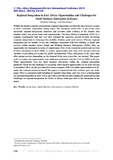| dc.contributor.author | Ochieng, Fredrick | |
| dc.contributor.author | Jonyo, Fred | |
| dc.date.accessioned | 2015-07-23T07:35:17Z | |
| dc.date.available | 2015-07-23T07:35:17Z | |
| dc.date.issued | 2015 | |
| dc.identifier.citation | Ochieng, Fredrick and Jonyo, Fred (2015). Regional integration in East Africa: opportunities and challenges for small business enterprises in Kenya | en_US |
| dc.identifier.uri | http://hdl.handle.net/11295/88665 | |
| dc.description.abstract | Within the global economic environment, regional integration provides the most favored avenue
to foster economic cooperation among states. The European Union (EU) is one of the most
successful regional integration platforms and provides valid evidence of the benefits that
member states can accrue from such organizations. The East African Community (EAC) is a
regional organization that has over time initiated the processes geared towards increasing
economic integration to encourage free mobility of labor, goods and services. Whereas regional
integration has its benefit, so are the challenges associated with free mobility of goods and
services within member states. Small and Medium Business Enterprises (SMEs) offer an
opportunity for thousands in terms of employment. Part of the reason for growth and survival
of these enterprises is their ability to explore opportunities that large scale investors don not
consider as providing an avenue for profit maximization. These enterprises at the same time
offer unique services depending on the demand of the area where they are located. This paper
seeks to explore the opportunities and challenges associated with the EAC to SMEs in Kenya.
What opportunities exist for small business enterprises within the regional integration
platform? What are the challenges to accessing wider market opportunities in the East African
Community? How can the government of Kenya support SMEs to exploit opportunities in EAC
under the common market protocol? The paper is organized into four sections, part one of the
paper offers a conceptual understanding of regional integration, part two covers a background
on regional integration in East Africa, part three provides an interrogation of opportunities and
challenges in regional integration for SMEs in Kenya while part four is the conclusion of the
paper. | en_US |
| dc.language.iso | en | en_US |
| dc.publisher | University of Nairobi | en_US |
| dc.subject | Integration, Small Business Enterprises, Common Market 1 | en_US |
| dc.title | Regional integration in East Africa: opportunities and challenges for small business enterprises in Kenya | en_US |
| dc.type | Article | en_US |
| dc.type.material | en_US | en_US |

